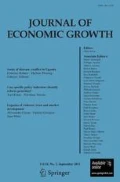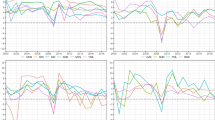Abstract
How does financial development affect economic growth: through its impact on accumulation of physical and human capital or by boosting total factor productivity (TFP) growth? We use a new data set on output, inputs, and total factor productivity for the US states to study this question. Unlike previous cross-country research that tries to disentangle the channels through which financial development impacts growth, we use a plausibly exogenous measure of financial development: the timing of banking deregulation across states during the period 1970–2000. At the same time our new data set allows us to go beyond what was previously done in the state banking deregulation literature and identify whether finance impacts states’ input accumulation or TFP growth. We find, in line with existing cross-country studies, that deregulation boosts growth by accelerating both TFP growth and the accumulation of physical capital without having any impact on human capital. In contrast to the cross-country studies, we also find that the effects of deregulation are largely independent of states’ initial level of development; both rich and poor states grow faster after deregulation. Additionally, since our data set breaks down aggregate output into three sectors: agriculture, manufacturing, and the remaining industries, we are able to show that deregulation accelerates the growth of productivity in manufacturing. This last finding answers an important critique of the banking deregulation studies which asserts that observed growth effects may be coming from the growth of financial industry itself and not from the beneficial effect of finance on other industries, such as manufacturing.




Similar content being viewed by others
Notes
Kroszner and Strahan (1999) find that the share of small banks was related to the likelihood of early deregulation. If for example, this share reflects a state’s legislators’ openness to all kinds of lobbying efforts, which could have other growth-reducing effect, the identification in (3) would be flawed.
Conversely, if states with decelerating growth are more likely to deregulate sooner, perhaps because deregulation is seen as a way to address the growth slowdown, the results would be biased in the opposite direction.
The use of GMM to estimate panel growth regression has become standard approach in the the literature. However, some authors caution against assuming the validity of its underlying assumptions. For example, Hauk and Wacziarg (2009) use a Monte Carlo study to demonstrate that GMM methods significantly overestimate the speed of convergence in panel growth regressions. We report GMM results mainly as a robustness check. In most cases the GMM results are very similar to those obtained using the more conventional methods.
We assigned the low income dummy to states in the bottom 1/3 of the 1970 GDP per worker distribution, the middle to the next 1/3 and so on. The excluded category is high income.
In the “other” sector, the effect is smaller in magnitude, and it is present only when a full set of controls is included in the regressions. The estimates for agriculture are far less conclusive.
In contrast, the “other” sector experiences a significant acceleration in the growth of capital per worker, with point estimates between 0.8 and 1.5 % and uniform statistical significance across all specifications. The effect on agriculture’s capital deepening is again inconclusive.
References
Aghion, P., Angeletos, G.-M., & Banerjee, A. (2011). Volatility and growth: Credit constraints and productivity-enhancing investment. Journal of Monetary Economics, 57(3), 246–265.
Aghion, P., Howitt, P., & Mayer-Foulkes, D. (2005). The effect of financial development on convergence: Theory and evidence. Quarterly Journal of Economics, 120(1), 173–222.
Arellano, M., & Bond, S. (1991). Some tests of specification for panel data. Review of Economic Studies, 58(2), 277–297.
Banerjee, A. V., & Newman, A. F. (1993). Occupational choice and the process of development. Journal of Political Economy, 101(2), 274–298.
Barro, R., & Sala-i-Martin, X. (1992). Convergence. Journal of Political Economy, 100(2), 223–251.
Barro, R. J., Mankiw, N. G., & Sala-i-Martin, X. (1995). Capital mobility in neoclassical models of growth. American Economic Review, 85(1), 103–115.
Beck, T., Levine, R., & Loayza, N. (2000). Finance and the Sources of Growth. Journal of Financial Economics, 58(1–2), 261–300.
Beck, T., Levine, R., & Levkov, A. (2010). Big bad banks? The winners and losers from bank deregulation in the United States. Journal of Finance, 65(5), 1637–1667.
Bils, M., & Klenow, P. J. (2000). Does schooling cause growth? American Economic Review, 90(5), 1160–1183.
Black, S. E., & Strahan, P. E. (2002). Entrepreneurship and bank credit availability. Journal of Finance, 17(6), 2807–2833.
Blundell, R., & Bond, S. (1998). Initial conditions and moment restrictions in dynamic panel data models. Journal of Econometrics, 87(1), 115–143.
Demirguc-Kunt, A., & Levine, R., (2008). Finance, financial sector policies, and long-run growth. Commission on Growth and Development, Working Paper No. 11, 2008, Washington, DC: The World Bank.
Galor, O., & Zeira, J. (1993). Income distribution and macroeconomics. Review of Economic Studies, 60(1), 35–52.
Greenwood, J., Sanchez, J. M., & Wang, C. (2010). Financing development: The role of information Costs. American Economic Review, 100(4), 1875–1891.
Hauk, W., & Wacziarg, R. (2009). A Monte Carlo study of growth regressions. Journal of Economic Growth, 14(2), 103–147.
Jayaratne, J., & Strahan, P. E. (1996). The finance-growth nexus: Evidence from bank branch deregulation. Quarterly Journal of Economics, 111(3), 639–670.
Jayaratne, J., & Strahan, P. E. (1998). Entry restrictions, industry evolution, and dynamic efficiency: Evidencefrom commercial banking. Journal of Law and Economics, 41(1), 239–273.
Jerzmanowski, M., & Nabar, M. (2013). Financial development and wage inequality: Theory and evidence. Economic Inquiry, 51(1), 211–234.
King, R. G., & Levine, R. (1993a). Finance and growth: Schumpeter might be right. Quarterly Journal of Economics, 108(3), 717–737.
King, R. G., & Levine, R. (1993b). Finance, entrepreneurship, and growth: Theory and evidence. Journal of Monetary Economics, 32(3), 513–542.
Kroszner, R. S., & Strahan, P. E. (1999). What drives deregulation? Economics and politics of the relaxation of bank branching restrictions. Quarterly Journal of Economics, 114(4), 1437–1467.
La Porta, R., Lopez-de-Silanes, F., & Shleife, A. (2008). The economic consequences of legal origins. Journal of Economic Literature, 46(2), 285–332.
Levine, R. (1997). Financial development and growth: Views and agenda. Journal of Economic Literature, 35(2), 688–726.
Levine, R. (1998). The legal environment, banks, and long-run economic growth. Journal of Money, Credit, and Banking, 30, 596–620.
Levine, R., & Zervos, S. (1998). Stock markets, banks, and economic growth. American Economic Review, 88(3), 537–558.
Levine, R., Loayza, N., & Beck, T. (2000). Financial intermediation and growth: Causality and causes. Journal of Monetary Economics, 46(2000), 31–77.
Levine, R. (2005). Finance and growth: theory and evidence. In P. Aghion & S. Durlauf (Eds.), Handbook of economic growth, 1st edn, (Vol. 1, 865–934). Elsevier.
McMillan, M. and Rodrik, D. (2011) . Globalization, Structural Change, and Productivity Growth, NBER Working Paper No. 17143, June.
Nickell, S. J. (1981). Biases in dynamic models with fixed effects. Econometrica, 49(6), 1417–1426.
Rioja, F., & Valev, N. (2004). Finance and the sources of growth at various stages of economic development. Economic Inquiry, 42(1), 127–140.
Sala-I-Martin, X., Doppelhofer, G., & Miller, R. I. (2004). Determinants of long-term growth: A Bayesian averaging of classical estimates (BACE) approach. American Economic Review, 94(4), 813–835.
Schumpeter, J. A. (1934). The theory of economic development: An inquiry into profits, capital, credit, interest and the business cycle, translated from the German by Redvers Opie, Harvard Economic Studies.
Turner, C., Tamura, R., & Mulholland, S. E. (2013). How important are human capital, physical capital and total factor productivity for determining state economic growth in the United States, 1840–2000? Journal of Economic Growth, 18(4), 319–371.
Turner, C., Tamura, R., Mulholland, S., & Baier, S. (2007). Education and Income of the States of the United States: 1840–2000. Journal of Economic Growth, 12, 101–158.
Valentinyi, A., & Herrendorf, B. (2008). Measuring factor income shares at the sectoral level. Review of Economic Dynamics, 11(4), 820–835.
Author information
Authors and Affiliations
Corresponding author
Additional information
I would like to thank the editor and the anonymous referees for many helpful comments and suggestions. All remaining errors are my own.
Electronic supplementary material
Below is the link to the electronic supplementary material.
Rights and permissions
About this article
Cite this article
Jerzmanowski, M. Finance and sources of growth: evidence from the U.S. states. J Econ Growth 22, 97–122 (2017). https://doi.org/10.1007/s10887-016-9135-6
Published:
Issue Date:
DOI: https://doi.org/10.1007/s10887-016-9135-6




